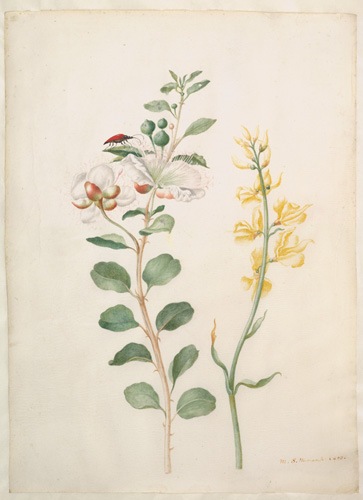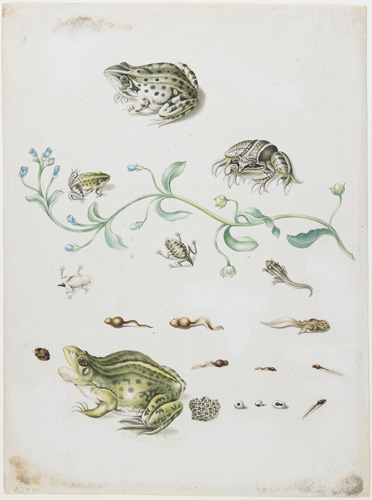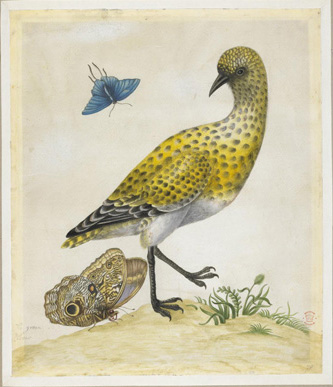Maria Sibylla Merian
Active in: Germany, the Netherlands, and Suriname
Biography
Maria Sibylla Merian is renowned for her botanical illustrations of European flora and fauna, as well as those she encountered in Dutch Suriname. She was born in Frankfurt am Main in 1647. In 1665, Merian married the painter Johann Andreas Graff.
Her first book of natural illustrations was published in 1675, and she produced a volume on caterpillars in 1679. After many relocations to tend to sick family members, as well as a stint in a Labadist community in Friesland, Merian’s husband divorced her in 1692. In 1699, she journeyed to Dutch Suriname, where she stayed until malaria forced her to return to the Dutch Republic in 1701. Merian died in Amsterdam in 1717, after a long career filled with numerous publications of insects, plants, and other natural illustrations.
Selected Works

Maria Sibylla Merian, Scarlet Ibis with an Egg, 1699–1700. Deck paint and gouache on parchment, 42.1 x 30.8 cm. Rijkmuseum

Maria Sibylla Merian, Watermelon with Caterpillar and Moth, 1705. Watercolor touched with bodycolor and with pen and gray ink on vellum, 36.8 x 28.6 cm. British Museum

Maria Sibylla Merian, Study of Capers, Gorse, and a Beetle, 1693. Watercolor with white gouache on vellum, 35.5 x 26.2 cm. Metropolitan Museum of Art
Circle
Daughter of
Matthäus Merian
Step-daughter of
Jacob Marrel
Bibliography
Andréolle, Donna Spalding, and Veronique Molinari, eds. Women and Science, Seventeenth Century to Present: Pioneers, Activists and Protagonists. Newcastle upon Tyne: Cambridge Scholars Publishing, 2011.
Beuys, Barbara. Maria Sibylla Meria. Künstlerin, Forscherin, Geschäftsfrau. Berlin: Insel Verlag, 2016.
Bott, Gerhard, ed. Kunst in Hessen und am Mittelrhein. Darmstadt: Roether, 1970.
Brafman, D., and S. Schrader. Insects and Flowers: The Art of Maria Sibylla Merian. Los Angeles, 2008.
Cristini, Luca Stefano. Flowers, butterflies, insects, caterpillars and serpents…: From the superb engravings of Sibylla Merian and Moses Hariss. Zanica: Soldiershop Publishing, 2014.
Dabbs, Julia K. Life Stories of Women Artists, 1550–1800: An Anthology. Burlington: Ashgate, 2009.
Davis, Natalie Zemon. Women on the Margins: Three Seventeenth-Century Lives. Cambridge: Harvard University Press, 1995.
Erlanger-Glozer, Liselotte. “Maria Sibylla Merian, 17th Century Entomologist, Artist, and Traveller.” Insect World Digest 3 (1978): 12–21.
Etheridge, Kay. “Maria Sibylla Merian’s Frogs.” Bibliotheca Herpetologica 8 (2010): 20–27.
Etheridge, Kay. “Maria Sibylla Merian and the metamorphosis of natural history.” Endeavour 35 (2011): 16–22.
Fine, Elsa Honig. Women & Art: A History of Women Painters and Sculptors from the Renaissance to the 20th Century. London: Allanheld & Schram, 1978.
Freedberg, David. “Science, Commerce, and Art: Neglected Topics at the Junction of History and Art History.” In Art in History, History in Art: Studies in Seventeenth-century Dutch culture. Edited by David Freedberg and Jan de Vries, 377–428. Chicago: University of Chicago Press, 1991.
Friedewald, Boris. Maria Sibylla Merians Reise zu den Schmetterlingen. Munich: Presel Verlag, 2015.
Grabowski, Carin. Maria Sibylla Merian zwischen Malerei und Naturforschung Pflanzen- und Schmetterlingsbilder neu entdeckt. Berlin: Dietrich Reimer Verlag, 2017.
Guentherodt, Ingrid. “Maria Cunitz und Maria Sibylla Merian: Pionierinnen der deutschen Wissenschaftssprache im 17. Jahrhundert.” Zeitschrift fur Germanistische Linguistik 14 (1986): 23.
Hacke, Daniela, and Paul Musselwhite. Empire of the Senses: Sensory Practices of Colonialism in Early America. Leiden: Brill, 2017.
Hildebrandt, Irma. Große Frauen: Portraits aus fünf Jahrhunderten. Diederichs Verlag, 2010.
Hollmann, E., and W. Beer. Maria Sibylla Merian, The St. Petersburg watercolours. Munich, 2003.
Houbraken, Arnold. De Groote schouburgh der Nederlantsche konstschilders en schilderessen. [1718–21]. Amsterdam: B. M. Israel, 1976.
Ilmakunnas, Johanna, Mariatta Rahikainen, and Kirsi Vainio-Korhonen. Early Professional Women in Northern Europe, ca. 1650–1850. Taylor and Francis, 2017.
Kaiser, Helmut. Maria Sibylla Merian: Eine Biographie. Artemis and Winkler, 1997.
Kerner, Charlotte. Seidenraupe, Dscungelblüte. Die Lebensgeschichte der Maria Sibylla Merian. Weinheim: Beltz and Gelberg, 1998.
Klein, JoAnna. “A Pioneering Woman of Science Re-Emerges After 300 Years.” The New York Times, January 24, 2017.
Klötzer, Wolfgang. Frankfurter Biographie. Zweiter Band: M-Z. Frankfurt am Main: Waldemar Kramer, 1996.
Kopaneva, N. P. “The Vivid Colors of Merian.” Science First Hand 25 (2010): 110–23.
Kristensen, Niels P. “Lepidoptera, moths and butterflies: Evolution, Systematics, and Biogeography.” In Handbuch der Zoologie: Eine Naturgeschichte der Stämme des Tierreiches. Edited by Niels P. Kristensen. Walter de Gruyter, 1999.
Kühn, Dieter. Frau Merian! Eine Lebensgeschichte. Berlin: Fischer, 2003.
Lachno, James. “Maria Sibylla Merian: Scientific Illustrator Honoured with Google Doodle.” The Daily Telegraph, April 2, 2013. http://d2ybq9unw89ve4.cloudfront.net/technology/google/google-doodle/9965980/Maria-Sibylla-Merian-Scientific-illustrator-honoured-with-Google-doodle.html.
Le-May Sheffield, Suzanne. Women and Science: Social Impact and Interaction. New Brunswick, NJ: Rutgers University Press, 2004.
Lendorff, Gertrud. Maria Sibylla Meria, 1647–1717. Ihr Leben und Werk. Basel, 1955.
Mancoff, Debra N. Frauen, die die Kunst veränderten. Munich: Prestel, 2012.
Merian, Maria Sibylla. Neues Blumenbuch. Vols. 1–3. Nürnberg, 1675–80.
Merian, Maria Sibylla. Metamorphosis insectorum Surinamensium 1705. Brussels: Lannoo Publishers and Koninklijke Bibliotheek, 2017.
Merian, Maria Sibylla. Der Raupen wunderbare Verwandlung und sonderbare Blumennahrung. Vols. 1–2. Nürnberg, Frankfurt, and Leipzig, 1679–83.
Merkel, Kerstin and Heide Wunder. Deutsche Frauen der Frühen Neuzeit: Dichterinnen, Malerinnen, Mäzeninnen. Darmstast: Wissenschaftliche Buchgesellschaft, 2000.
Neri, Janice. The Insect and the Image: Visualizing Nature in Early Modern Europe, 1500–1700. Minneapolis: University of Minnesota Press, 2011.
O’Malley, Sarah. “Maria Sibylla Merian: Neues Blumenbuch/New Book of Flowers.” Southeastern Naturalist 4 (2005): 192.
Parker, Rozsika, and Griselda Pollock. Old Mistresses: Women, Art and Ideology. London: Routledge & Kegan Paul, 1981.
Pfister-Burckhalter, Margarete. Maria Sibylla Merian: Leben und Werk, 1647–1717. Basel: G-S Verlag, 1980.
Pieters, F. F. J. M., and D. Winthagen. “Maria Sibylla Merianm Naturalist and Artist (1647–1717): A Commemoration on the Occasion of the 350th Anniversary of Her Birth.” Archives of Natural History 26 (1999): 1–18.
Pomeroy, Sarah, and Jeyareny Kathirithamby. Maria Sibylla Merian: Artist, Scientist, Adventurer. Los Angeles: J. Paul Getty Museum, 2018.
Reidell, Heidi. “A Study of Metamorphosis.” Americas 60 (2008): 28–35.
Reitsma, Ella. Maria Sibylla Merian and Daughters: Women of Art and Science. Zwolle: Waanders, 2008.
Schmidt-Loske, Katharina. Die Tierwelt der Maria Sibylla Merian. Marburg: Basilisken-Presse im Verlag Natur und Text, 2007.
Schubert, Kathrin. Maria Sibylla Merian. Reise nach Surinam. Munich: Frederking & Thaler, 2010.
Schwarz, Ruth and Fritz F. Steininger. Maria Sibylla Merian. Lebensbilder. Frankfurt am Main: Schwarz, 2006.
Swaby, Rachel. Headstrong: 52 Women who Changed Science – And the World. New York: Broadway Books, 2015.
Todd, Kim. Chrysalis: Maria Sibylla Merian and the Secrets of Metamorphosis. Orlando: Harcourt, 2007.
Todd, Kim. “Maria Sibylla Merian (1647–1717): An Early Investigator of Parasitoids and Phenotypic Plasticity.” Terrestrial Arthropod Reviews 4 (2011): 131–44.
Trepp, Anne-Charlotte. “Insekten-Metamorphose als Passion oder Maria Sibylla Merians langer Weg zur Wiedergeburt.” In Von der Glückseligkeit alles zu wissen. Die Erforschung der Natur als religiöse Praxis in der Frühen Neuzeit (1550–1750), 210ff. Frankfurt am Main and Munich: Campus-Verlag, 2009.
Ullmann, Ernst, ed. Maria Sibylla Merian: Leningrader Aquarelle. Luzern, 1974.
Weidemann, Christianne, Petra Larass, and Melanie Klier. 50 Women Artists You Should Know. Munich: Prestel, 2016.
Wettengl, Kurt, ed. Maria Sibylla Merian 1647–1717: Artist and Naturalist. Translated by John S. Southard. Ostfildern: Gerd Hatje, 1998.
Wulf, Andrea. “The Woman Who Made Science Beautiful.” The Atlantic, January 19, 2016. https://www.theatlantic.com/science/archive/2016/01/the-woman-who-made-science-beautiful/424620/.
Zemon Davis, Natalie. Metamorphosen. Das Leben der Maria Sibylla Merian. Berlin: Wagenbach Verlag, 2003.
Zemon Davis, Natalie. Women on the Margins: Three Seventeenth-Century Lives. Cambridge: Harvard University Press, 1995.

